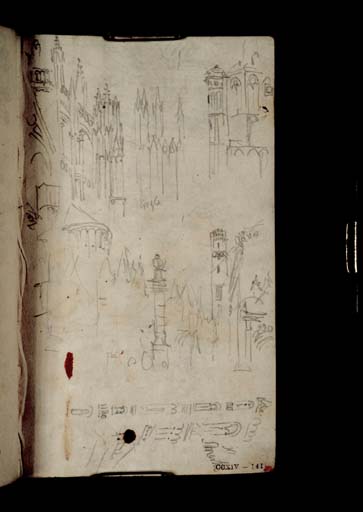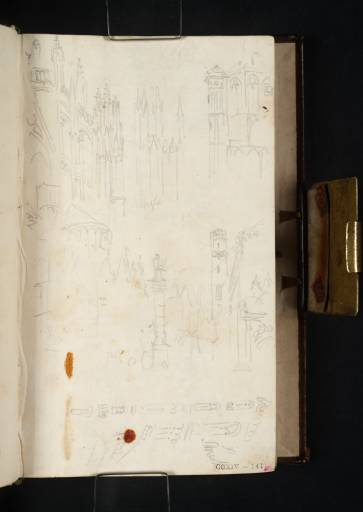Joseph Mallord William Turner Flying Buttresses and Tracery at the East End of Cologne Cathedral; the Tower of the Rathaus; the Great St Martin Church and the Stapelhaus from the Fischmarkt; the Upper Stages of St Martin's Tower 1825
Image 1 of 2
-
 Joseph Mallord William Turner, Flying Buttresses and Tracery at the East End of Cologne Cathedral; the Tower of the Rathaus; the Great St Martin Church and the Stapelhaus from the Fischmarkt; the Upper Stages of St Martin's Tower 1825
Joseph Mallord William Turner, Flying Buttresses and Tracery at the East End of Cologne Cathedral; the Tower of the Rathaus; the Great St Martin Church and the Stapelhaus from the Fischmarkt; the Upper Stages of St Martin's Tower 1825 -
 Joseph Mallord William Turner, Flying Buttresses and Tracery at the East End of Cologne Cathedral; the Tower of the Rathaus; the Great St Martin Church and the Stapelhaus from the Fischmarkt; the Upper Stages of St Martin's Tower 1825 (Enhanced image)Enhanced image
Joseph Mallord William Turner, Flying Buttresses and Tracery at the East End of Cologne Cathedral; the Tower of the Rathaus; the Great St Martin Church and the Stapelhaus from the Fischmarkt; the Upper Stages of St Martin's Tower 1825 (Enhanced image)Enhanced image
Joseph Mallord William Turner,
Flying Buttresses and Tracery at the East End of Cologne Cathedral; the Tower of the Rathaus; the Great St Martin Church and the Stapelhaus from the Fischmarkt; the Upper Stages of St Martin's Tower
1825
Joseph Mallord William Turner 1775–1851
Folio 141 Recto:
Flying Buttresses and Tracery at the East End of Cologne Cathedral; the Tower of the Rathaus; the Great St Martin Church and the Stapelhaus from the Fischmarkt; the Upper Stages of St Martin’s Tower 1825
D19118
Turner Bequest CCXIV 141
Turner Bequest CCXIV 141
Pencil on white wove paper, 155 x 95 mm
Inscribed by Turner ‘G[?gle]’ (?gargoyle) above centre, below tracery, and ‘[...] | S Martin’ bottom right, descending vertically
Inscribed by John Ruskin in red ink ‘41’ bottom right
Stamped in black ‘CCXIV – 141’ bottom right
Inscribed by Turner ‘G[?gle]’ (?gargoyle) above centre, below tracery, and ‘[...] | S Martin’ bottom right, descending vertically
Inscribed by John Ruskin in red ink ‘41’ bottom right
Stamped in black ‘CCXIV – 141’ bottom right
Accepted by the nation as part of the Turner Bequest 1856
References
1909
A.J. Finberg, A Complete Inventory of the Drawings of the Turner Bequest, London 1909, vol.II, p.656, CCXIV 141, as ‘A church – “St. Martin,” Cologne’.
1980
Agnes von der Borch and Gerhard Bott, J.M. William Turner: Köln und der Rhein: Aquarelle Zeichnungen Skizzenbücher Stiche, exhibition catalogue, Wallraf-Richartz-Museum, Cologne 1980, p.70 under no.26, as Cologne subject.
1995
Cecilia Powell, Turner in Germany, exhibition catalogue, Tate Gallery, London 1995, pp.34, 77 note 20.
In the first of numerous pages surveying Cologne in the present book, fragmentary studies of three of the city’s major landmarks jostle for space across three descending bands. At the top left, the Gothic tracery and pinnacles belong to the medieval flying buttresses radiating between the windows of Cologne Cathedral’s apsidal east end; the element at the top centre appears to be a continuation downwards from the right-hand side of the first study. In 1817, Turner had made a careful view focusing on the whole of the east end, then the only completed part of the building except the lower stages of the south-western tower, in the Rhine sketchbook (Tate D12981; Turner Bequest CLXI 53). Compare also folio 147 recto (D19130) in the present book, a view of the whole cathedral from the south-east supplemented by more details of the intricate stonework, and folio 143 verso (D19123), including a fragmentary study which may show part of the interior.
At the top right is the upper part of the Gothic Ratsturm tower of the city’s Rathaus (town hall), a few blocks south of the cathedral, seen from the east with its staircase turret at the left; there are also hints of the substantial spire over the main tower. Turner had studied the building from street level in the 1817 Rhine book, making a detailed drawing of its Renaissance loggia with the tower rising steeply beyond (Tate D12988; Turner Bequest CLXI 57). Given the head-on elevations of the high-up details of the cathedral and town hall presented here, they were perhaps studied at shallow angles from across the Rhine, in conjunction with one of the river views in the contemporary Holland, Meuse and Cologne sketchbook (Tate D19510–D19511; Turner Bequest CCXV 66a–67).
Below the centre comes a street view just off the riverfront not far east of the Rathaus, with the apsidal east end of the Romanesque Great St Martin church (Groß Sankt Martin) over the steep gables on the left, as correctly identified by Finberg.1 The setting is the Fischmarkt, with the octagonal stair tower of the Stapelhaus (originally a medieval ‘stacking house’ depot for the fish trade) on its north side towards the right. The building was largely destroyed in the Second World War, with the tower incorporated into a plainer modern building. The central feature, a rusticated pillar topped by an urn, is shown in front of a long terrace of tall, narrow houses in an 1826 engraving from a similar viewpoint;2 a few of the façades survive on the square, but a sculptural ‘Feschwievern’ (fishwives) fountain now stands in place of the pillar. At right-angles along the bottom of the page, the same side of the church’s tower is extended upwards to its full height, omitting its pinnacles and spire. There are views of the tower from around the nearby Fischerpforte gateway on folio 143 verso (D19123).
Like most of Cologne, by the end of the Second World War in 1945 the church was all but destroyed, but has since been fully rebuilt. Other prominent restored landmarks, including many more Romanesque churches and some of the gate-towers recorded by Turner, are still recognisable, albeit mostly surrounded by modern structures. The defensive Rheinmauer walls and bastions along the river which appear in numerous drawings had already been taken down towards the end of the nineteenth century, surviving long enough to be photographed, and three later bridges now span the Rhine between the central Altstadt districts and Deutz on the east bank. In 1825 the only crossing was a bridge of boats, opened in 18223 (see in particular folio 146 verso; D19129) at about the point where the Deutzer Brücke now stands. Today, the other central crossings are the Hohenzollernbrücke rail bridge to its north, due east of the cathedral, and the Severinsbrücke to the south; all three intrude on the artist’s open prospects of the Rhine.
St Martin’s was the most prominent and picturesque riverside feature in Turner’s time, given the half-completed, quasi-ruinous state of the nearby cathedral, with a large medieval crane still sitting abandoned atop the tower (now one of the soaring twin west steeples). The church duly dominates the major outcome of the 1825 tour, a large oil painting of Cologne, the Arrival of a Packet Boat, Evening, exhibited at the Royal Academy the following year (Frick Collection, New York),4 looking south from about level with the cathedral, past the church to the distant bridge of boats. The painting is fully discussed under folio 143 recto (D19122), one of the sketches which relate directly to it. Turner perhaps referred to the study at the bottom of this page for the articulation of St Martin’s tower, as suggested by the oil stains described in the technical notes below.
The artist had presumably reached the city along the river directly from Düsseldorf (see under folio 138 recto; D19112), travelling about twenty miles upstream to the south-south-east. Cecilia Powell has observed that this was ‘the third year he was passing through Cologne and Aachen’ (otherwise Aix-la-Chapelle), his next stop, about forty miles overland to the west; see under folio 151 verso (D19139). ‘His sketches suggest that he deliberately paid careful attention to Cologne, as though compensating for having neglected it in 1824’,5 with sketches between here and folio 147 recto, and on folios 148 recto–150 recto, 151 recto, 154 verso and 164 verso (D19119–D19130, D19132–D19136, D19138, D19145, D19165). For panoramic river views in the contemporary Holland, Meuse and Cologne sketchbook, see under Tate D19457 (Turner Bequest CCXV 31a).6
Over the years, Turner’s direct engagement with the city was extensive,7 summarised here in terms of the sketchbooks he used (all Tate): 1817’s Itinerary Rhine Tour, Waterloo and Rhine and Rhine (Turner Bequest CLIX, CLX, CLXI); 1824’s Rivers Meuse and Moselle (CCXVI); 1833’s Brussels up to Mannheim – Rhine and Rotterdam and Rhine (CCXCVI, CCCXXII); 1835’s Prague, Nuremberg, Frankfurt and Rhine (CCCIV); 1840’s Würzburg, Rhine and Ostend (CCCIII); and 1844’s Rhine and Rhine Castles (CCCLI).
There are two finished 1817 watercolours of the city: The Rhine Gate, Cologne (National Museum Wales, Cardiff), prefiguring the 1826 painting,8 and Cologne (currently untraced).9 Subsequent watercolours are Cologne, of about 1820 (currently untraced),10 and that year’s Cologne from the River (Seattle Art Museum).11 All but the first are variant views downriver from near the Bayenturm tower,12 engraved in 1824 (Tate impression: T06068) and 1859 (T05195, T06323). Cologne (Courtauld Gallery, London),13 a slightly fanciful vignette with St Martin’s and the cathedral, was engraved for Byron’s Works in 1833 (Tate impression: T06189).
All show prospects along the west bank, as does a loose colour study, perhaps made some time between 1824 and 1832 (Tate D25312; Turner Bequest CCLXIII 190), unrelated to any finished composition but showing the city beyond the bridge of boats, as do two undated pencil and chalk sketches on grey paper (D33685, D33918; CCCXLI 10, 212). Another grey sheet (D34183; CCCXLI 444) appears to depict the converse view towards Deutz Abbey.
Imaged without further details at ‘Fischmarkt – Köln im Wandel der Zeit 1800–1900’, Bilderbuch Köln, accessed 16 June 2020, http://www.bilderbuch-koeln.de/Fotos/altstadt_nord_fischmarkt_historisch_stiche_gerhards_56417 (website subsequently discontinued).
See Cecilia Powell, Turner’s Rivers of Europe: The Rhine, Meuse and Mosel, exhibition catalogue, Tate Gallery, London 1991, p.111 under nos.22, 23.
Martin Butlin and Evelyn Joll, The Paintings of J.M.W. Turner, revised ed., New Haven and London 1984, pp.141–3 no.232, pl.235 (colour).
Most of the pages are listed ibid., p.77 note 20, many in the two books having been identified in Finberg 1909, II, pp.656, 663, 664.
Technical notes:
Matthew Imms
September 2020
How to cite
Matthew Imms, ‘Flying Buttresses and Tracery at the East End of Cologne Cathedral; the Tower of the Rathaus; the Great St Martin Church and the Stapelhaus from the Fischmarkt; the Upper Stages of St Martin’s Tower 1825 by Joseph Mallord William Turner’, catalogue entry, September 2020, in David Blayney Brown (ed.), J.M.W. Turner: Sketchbooks, Drawings and Watercolours, Tate Research Publication, March 2023, https://www

